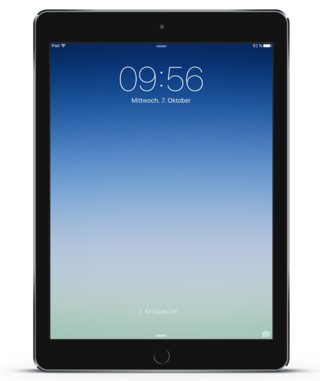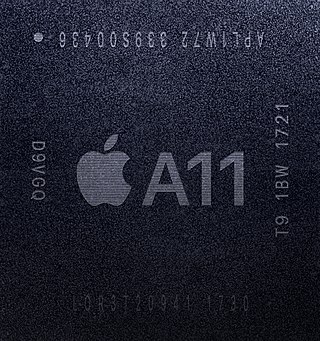
The iPod Nano is a discontinued portable media player designed and formerly marketed by Apple Inc. The first-generation model was introduced on September 7, 2005, as a replacement for the iPod Mini, using flash memory for storage. The iPod Nano went through several models, or generations, after its introduction. Apple discontinued the iPod Nano on July 27, 2017.

Apple TV is a digital media player and microconsole developed and marketed by Apple. It is a small piece of networking hardware that sends received media data such as video and audio to a TV or external display. Its media services include streaming media, TV Everywhere-based services, local media sources, and sports journalism and broadcasts.

iOS is a mobile operating system developed by Apple exclusively for its devices. It was unveiled in January 2007 for the first-generation iPhone, which launched in June 2007. Major versions of iOS are released annually; the current stable version, iOS 18, was released to the public on September 16, 2024.

The iPhone 3G is a smartphone developed and marketed by Apple Inc. It is the second generation of iPhone, successor to the original iPhone, and was introduced on June 9, 2008, at the WWDC 2008 which took place at the Moscone Center in San Francisco.
iOS jailbreaking is the use of a privilege escalation exploit to remove software restrictions imposed by Apple on devices running iOS and iOS-based operating systems. It is typically done through a series of kernel patches. A jailbroken device typically permits root access within the operating system and provides the right to install software unavailable through the App Store. Different devices and versions are exploited with a variety of tools. Apple views jailbreaking as a violation of the end-user license agreement and strongly cautions device owners not to try to achieve root access through the exploitation of vulnerabilities.

The iPhone is the first iPhone model and the first smartphone developed and marketed by Apple Inc. After years of rumors and speculation, it was officially announced on January 9, 2007, and was released in the United States on June 29, 2007.

The iPad is a tablet computer developed and marketed by Apple Inc. It is the third device in the iPad line of tablets. It added a Retina Display, the new Apple A5X chip with a quad-core graphics processor, a 5-megapixel camera, HD 1080p video recording, voice dictation, and support for LTE networks in North America. It shipped with iOS 5, which provides a platform for audio-visual media, including electronic books, periodicals, films, music, computer games, presentations and web browsing.

The iPad is a tablet computer developed and marketed by Apple Inc. Compared to its predecessor, the third-generation iPad, the fourth-generation iPad maintained the Retina Display but featured new and upgraded components such as the Apple A6X chip and the Lightning connector, which was introduced on September 12, 2012. It shipped with iOS 6, which provides a platform for audio-visual media, including electronic books, periodicals, films, music, computer games, presentations and web content. Like the third-generation iPad it replaced, it was supported by five major iOS releases, in this case iOS 6, 7, 8, 9, and 10.

The iPhone 5c is a smartphone that was developed and marketed by Apple Inc. It is part of the sixth generation of the iPhone. The device was unveiled on September 10, 2013, and released on September 20, 2013, along with its higher-end counterpart, the iPhone 5s. The "c" in the iPhone 5c's name stands for "color".

The iPad Air is a tablet developed and marketed by Apple Inc. It was announced on October 22, 2013, and was released on November 1, 2013. Part of the iPad line of tablet computers, the iPad Air features a thinner design than its predecessors, with similarities to the contemporaneous iPad Mini 2.

The iPad Mini 2 is a tablet computer designed and marketed by Apple Inc. It has a nearly identical design to its predecessor, the first-generation iPad Mini, but features internal revisions such as the use of an A7 system-on-a-chip and a 2,048 x 1,536 resolution Retina Display. Internally, the second-generation iPad Mini has nearly the same hardware as its sibling device, the iPad Air. Apple released the second-generation iPad Mini in space gray and silver colors on November 12, 2013.

The iPad Mini, known retrospectively as the iPad Mini 1, is the first generation of the mini tablet computer developed and marketed by Apple Inc. It was announced on October 23, 2012, as the fourth major product in the iPad line and the first of the iPad Mini line. It features a reduced screen size of 7.9 inches (20 cm), compared to the 9.7-inch (25 cm) display on standard iPads at that time.

The fifth generation iPod Touch is a mobile device designed and marketed by Apple Inc. with a touchscreen-based user interface. The successor to the 4th-generation iPod Touch, it was unveiled at Apple's media event alongside the iPhone 5 on September 12, 2012, and was released on October 11, 2012. It is compatible with up to iOS 9.3.5, which was released on August 25, 2016.

iPhone OS 2 is the second major release of the iOS mobile operating system developed by Apple Inc., being the successor to iPhone OS 1. It was the first version of iOS to support third-party applications via the App Store. iPhone OS 2.2.1 is the final version of iPhone OS 2. It was succeeded by iPhone OS 3 on June 17, 2009.

The iPad Air 2 is the second-generation iPad Air tablet computer developed and marketed by Apple Inc. It was announced on October 16, 2014, alongside the iPad Mini 3, both of which were released on October 22, 2014. The iPad Air 2 is thinner, lighter and faster than its predecessor, the first-generation iPad Air, and features Touch ID with the height, width and screen size the same as the iPad Air.

The iPad Mini 3 is the third-generation iPad Mini tablet computer developed and marketed by Apple Inc. It was announced alongside the iPad Air 2 on October 16, 2014 and released on October 22. It uses primarily the same design and hardware as that of its predecessor, the iPad Mini 2. Its new features are the addition of the Touch ID sensor compatible with Apple Pay, differing storage sizes and being available in a gold color, as well as the previous colors.

The sixth generation iPod Touch is a discontinued mobile device designed and marketed by Apple Inc. with a touchscreen-based user interface. It is the successor to the iPod Touch, becoming the first major update to the iPod lineup in more than two and a half years. It was released on the online Apple Store on July 15, 2015, along with minor upgrades to the iPod Nano and iPod Shuffle. This generation of iPod Touch was officially discontinued by Apple on May 28, 2019, with the release of its next-generation successor. It supports up to iOS 12.5.7, released on January 23, 2023.

The Apple A11 Bionic is a 64-bit ARM-based system on a chip (SoC) designed by Apple Inc., part of the Apple silicon series, and manufactured by TSMC. It first appeared in the iPhone 8 and 8 Plus, and iPhone X which were introduced on September 12, 2017. Apple states that the two high-performance cores are 25% faster than the Apple A10's and the four high-efficiency cores are up to 70% faster than the two corresponding cores in the A10. The A11 Bionic chip was discontinued on April 15, 2020, following the discontinuation of the iPhone 8 and 8 Plus. The latest software update for the iPhone 8 & 8 Plus and iPhone X using this chip was iOS 16.7.10, released on September 3, 2024.

The seventh generation iPod Touch is a discontinued mobile device designed and marketed by Apple Inc. with a touchscreen-based user interface. It is the successor to the 6th-generation iPod Touch, the first major update to the line since 2015. It was released on May 28, 2019, and discontinued on May 10, 2022. It was the final product in Apple's iPod product line.























